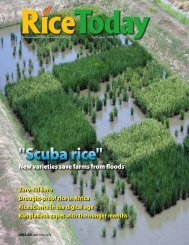How much water does rice need? - adron.sr
How much water does rice need? - adron.sr
How much water does rice need? - adron.sr
Create successful ePaper yourself
Turn your PDF publications into a flip-book with our unique Google optimized e-Paper software.
about 10:15 a.m., arrivingtwo hours later. The wholecity was buzzing withdemonstrators. Signs onevery wall denounced theGang of Four. Crowds ofpeople were either reading thesigns or forming ranks to marchbehind red banners. Shanghai hadbeen the headquarters for the Gangof Four. The demonstration was verywell organized and a great victory forthe people (meaning Deng Xiaoping,about whom I will say more later).We were asked to stay in our hotelexcept when escorted by our hosts,and to take no photos. <strong>How</strong>ever, wewere able to hold discussions withscientists and make visits to twocommunes. We learned quite a bitmore about the accounting systemand taxation procedures—commune,brigade, production team—<strong>much</strong>of which carried over into today’sfarm and village structure with thedismantling of the commune system.One evening, members of S.H.Ou’s family came to visit him. Hemet them in the lobby, which hefelt was safer than meeting in hi<strong>sr</strong>oom. When I asked him laterwhat the family thought of thedemonstrations, he said: “We didn’tdiscuss this, only family matters.”Guangzhou, 21-26 OctoberOn the 21st, we flew from Shanghai toGuangzhou, where authorities werepreparing a celebration of the people’svictory over the Gang of Four. Toavoid the crowds, we were taken to ahotel at the Zhonghua hot springs.We were briefed at theGuangdong Provincial Academyof Agricultural Sciences by a <strong>rice</strong>specialist, Lao Yanhai, who hadbeen to IRRI. A main focus ofplant breeding was on the threecropsystem of <strong>rice</strong>, which theyclaimed would yield 16 tons ormore per hectare per year overthree crops. They were even tryingto introduce a fourth annual crop,<strong>rice</strong> followed by wheat, soybeans,or rapeseed. The breeding stressedearly maturity, resistance to insectsand disease, and high yield.At this point, I want to digressand point out that each briefingwas preceded by a short politicalspeech. One of the Chinese scientistsbegan his talk as follows:“Since the liberation, underthe guidance of Mao Zedong,following the movement to deepenthe criticism of Deng Xiaoping, therightist revolutionary, following theprinciple of learning from Dazhai,and carrying on our work in a selfreliantway, we reformed the croppingsystem to grow three crops of <strong>rice</strong>.”It was quite a mouthful.Later, I asked our Mr. Huang ifDeng Xiaoping was wrong in hisagricultural policy. He answeredthat Deng had the wrong attitudeabout Dazhai. Dazhai was a brigadein Shanxi Province that had, asthe saying goes, “pulled itself upby its bootstraps,” although somesaid they received a lot of help fromthe government. Everywhere wewent, there were big red bannersproclaiming: “In agriculture learnfrom Dazhai.” Apparently, DengXiaoping felt there should be moreemphasis on economic developmentrather than taking the conceptof self-reliance, as expressedin Dazhai, to the extreme.Deng Xiaoping, of course, havingoutmaneuvered the Gang of Four,would soon become de facto leaderof China, replacing his long-timefriend, Zhou Enlai, who died ofcancer in January 1976. Althoughhe never held office as the head ofstate or the head of government,Deng served as de facto leader from1978 to the early 1990s. Under hisleadership, China established an openmarket economy and abolished thecommunes in favor of small familyfarms. The increase in productivitywas dramatic and, a decade laterin the late 1980s, Vietnam wouldfollow the Chinese policy, alsoboosting productivity remarkably.One evening, we were takento see an “opera.” This was notthe kind of Chinese opera that wewere familiar with. Instead, it wasa play in which the Communistswere fighting the Nationalists.At one point, it seemed that theNationalists had the Communistspinned down. “Go over to the nexthill and get the Party Secretary!He will tell us what to do.”At all of the major stops, wehanded out publications and <strong>rice</strong>varieties and received publicationsin return. We also brought handoperatedfertilizer placementmachines. In 1976, as in 2008, therewas a worldwide energy and fertilizershortage. IRRI was experimentingwith methods of placement toimprove fertilizer-use efficiency.On the next to last day of ourtour, we visited the Syin Hwa People’sCommune about 40 km northwest ofGuangzhou. S.K. De Datta and I wereat a brigade research station. I saidto S.K., “You see that implement overin the corner? That looks just likeour fertilizer placement machine.”We began asking questions, andlearned in our discussions thatdeep placement had been widelypracticed in southern China sincethe late 1960s. Shouichi Yoshida toldus that a Japanese team discussedthis method with the Chinesein the mid-1960s. His uncle hadhelped to popularize the methodin Japan during World War II.Homeward boundOn the 25th, Nyle Brady left forHong Kong and then Washington,D.C. On the morning of the 27th,the rest of us boarded the train forHong Kong and left as we had come.The trip marked the beginning ofdramatic changes in China and ofa close relationship between Chinaand IRRI. Back at IRRI, we met thestaff at the guesthouse to report onour trip and later published a reportin English and Chinese (with a redcover), Rice research and productionin China: an IRRI team’s view,which detailed our observations.Dr. Barker headed the Department ofAgricultural Economics at IRRI from1966 to 1978. In 2007-08, he returnedto IRRI as acting head of the SocialSciences Division. He extends histhanks to those who made the tripwith him and others for their usefulcomments.Rice Today January-March 200927

















